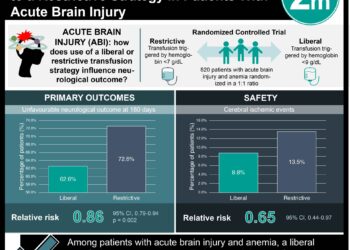2 Minute Medicine Rewind December 7 – December 14, 2014
In this section, we highlight the key high-impact studies, updates, and analyses published in medicine during the past week.
In 2011, the Accreditation Council for Graduate Medical Education (ACGME) instituted a number of resident duty hour reforms out of concern that resident fatigue was contributing to poorer clinical outcomes, among other reasons. This observational study sought to answer whether there was a difference in patient mortality and readmission rates among Medicare patients before and after the resident duty hour changes. This study included a total of 6,384,273 patient admissions for acute myocardial infarction, stroke, GI bleeding, congestive heart failure, or a diagnosis classification of general, orthopedic, or vascular surgery. After comparing data from admissions two years before duty hour reforms to data from the first year after reforms, investigators found no significant differences in mortality after adjusting for teaching hospital intensity across all medical conditions combined (OR 1.00, 95% CI 0.96-1.03), all surgical categories combined (OR 0.99 95% CI 0.94-1.04) or for any individual condition. This was similarly no difference in readmission rates for combined medical conditions (OR 1.00, 95% CI 0.97-1.02) or combined surgical categories (OR 1.00, 95% CI 0.98-1.03). This study therefore showed that among Medicare patients there was no significant difference in either mortality or readmission rates following the resident duty hour restriction changes.
Very Early Administration of Progesterone for Acute Traumatic Brain Injury
Progesterone has been proposed as a potential treatment for traumatic brain injury (TBI) given its effects as a neurosteroid on reducing cerebral edema, neuronal loss, and behavioral deficits with favorable results shown in animal models as well as two recent single-center clinical trials. In this larger, multicenter, randomized control trial, 882 patients with Glasgow Coma Scale scores of 4 to 12 (moderate to severe acute TBI) were randomized to intravenous progesterone or placebo within 4 hours after injury. This trial was stopped prematurely because of futility. This study found no significant difference between the patients receiving progesterone and those receiving placebo with regards to likelihood of achieving a favorable outcome, defined as improving beyond a specific Extended Glasgow Outcome Scale (GOS-E) score depending on initial GCS score (relative benefit of progesterone 0.95, 95% CI 0.85 – 1.06, p = 0.35). Phlebitis or thrombophlebitis was more frequently experienced in the intervention group compared to the control group (relative risk 3.03, 95% CI 1.96 – 4.66). This study therefore failed to demonstrate a significant improvement in TBI outcomes at 6 months for patients receiving progesterone after sustaining moderate to severe TBI.
Blood Pressure in Early Autosomal Dominant Polycystic Kidney Disease
In patients with autosomal dominant polycystic kidney disease (ADPKD) it is thought that activation of the renin-angiotensin-aldosterone system (RAAS) promotes renal-cyst growth through its mitogenic effects, thereby hastening the progression to end-stage renal disease (ESRD). Indeed, hypertension is also associated with progression to ESRD. In this randomized control trial, researchers sought to elucidate whether more aggressive antihypertensive therapy and usage of RAAS inhibitors could delay the onset of ESRD in patients with ADPKD. The study randomized 558 hypertensive patients with ADPKD to either a standard blood pressure target (120-130/70-80) or lower blood pressure target (95-110/60-75) using either lisinopril plus the angiotensin-receptor blocker telmisartan or lisinopril plus placebo. Researchers found that while the lower blood pressure target group had a significantly lower annual percentage increase in total kidney volume (5.6% vs. 6.6%, p = 0.006), there was no difference between the lisinopril+telmisartan and lisinopril+placebo groups. There was also no difference in rate of GFR decline between low blood pressure and normal blood pressure target groups (-2.9ml/min/1.73m2/yr vs. -3.0ml/min/1.73m2/yr, p = 0.55) as well as between liniopril+telmisartan and lisinopril+placebo groups (-3.00ml/min/1.73m2/yr vs. -2.86ml/min/1.73m2/yr, p = 0.55). The low pressure group did show significantly greater decrease in left ventricular mass index and urinary albumin excretion when compared to the normal blood pressure group. There were also significantly higher rates of dizziness and light-headedness with low blood pressure targeting. This study therefore shows that although adding telmisartan did not improve ADPKD disease measures, more rigorous blood pressure control did slow the increase in kidney volume as well as cause a greater decrease in left ventricular mass index and urinary albumin excretion.
The American Board of Internal Medicine (ABIM) initiated a mandatory Maintenance of Certification (MOC) program starting in 1990, requiring all physicians to be recertified every 10 years. This study researched whether mandatory recertification was associated with differences in care outcomes, specifically looking at rates of Ambulatory care-sensitive hospitalizations (hospitalizations due to conditions thought to be preventable through better outpatient care) among Medicare beneficiaries, as well as healthcare costs. Investigators analyzed these outcomes for 951 physicians initially certified in 1991 who had mandated recertification in 2001 and compared them to 974 physicians who were initially certified in 1989 and were grandfathered out of the MOC requirements. Researchers found that the MOC requirement was not statistically correlated with differences in the growth of the annual rate of ACSH (0.1 per 1000 beneficiaries, 95% CI -1.7 – 1.9, p = 0.92) but did find that physicians who had mandatory recertification had a smaller growth in per-beneficiary healthcare cost when compared to their peers who did not have MOC requirements (cohort difference -$167, 95% CI -$270.50 – -$63.50, p = 0.002). This study therefore shows that while the MOC requirements did not appear to alter the rates of ACSH, they did produce a small but statistically significant reduction in healthcare costs.
Vitamin A supplementation in children from the age of 6 to 59 months is known to improve child survival. However, whether such supplementation should be extended earlier into the neonatal period is uncertain. In this randomized control trial in Tanzania, 15,995 newborns were randomly assigned to receive Vitamin A during the first 3 days of life and were compared to 16,004 newborns receiving placebo. This study found that there was no statistically significant difference in mortality at 6 months for infants in the intervention group compared to those in the control group (26 deaths vs. 24 deaths per 1000 live births respectively, RR 1.10, 95% CI 0.95 – 1.26, p = 0.193). There was similarly no difference observed when stratifying the patient population by gender. There were no recorded adverse effects from the intervention. This paper therefore suggests that Vitamin A supplementation during the first 3 days of life does not provide any additional benefit with regards to infant mortality within the first 6 months. These results should be taken in the context of two other recently published randomized control trials, one in India and the other in Ghana, with the former study showing a small benefit to Vitamin A supplementation and the latter showing no difference.
Image: PD
©2014 2 Minute Medicine, Inc. All rights reserved. No works may be reproduced without expressed written consent from 2 Minute Medicine, Inc. No article should be construed as medical advice and is not intended as such by the authors, editors, staff or by 2 Minute Medicine, Inc.







